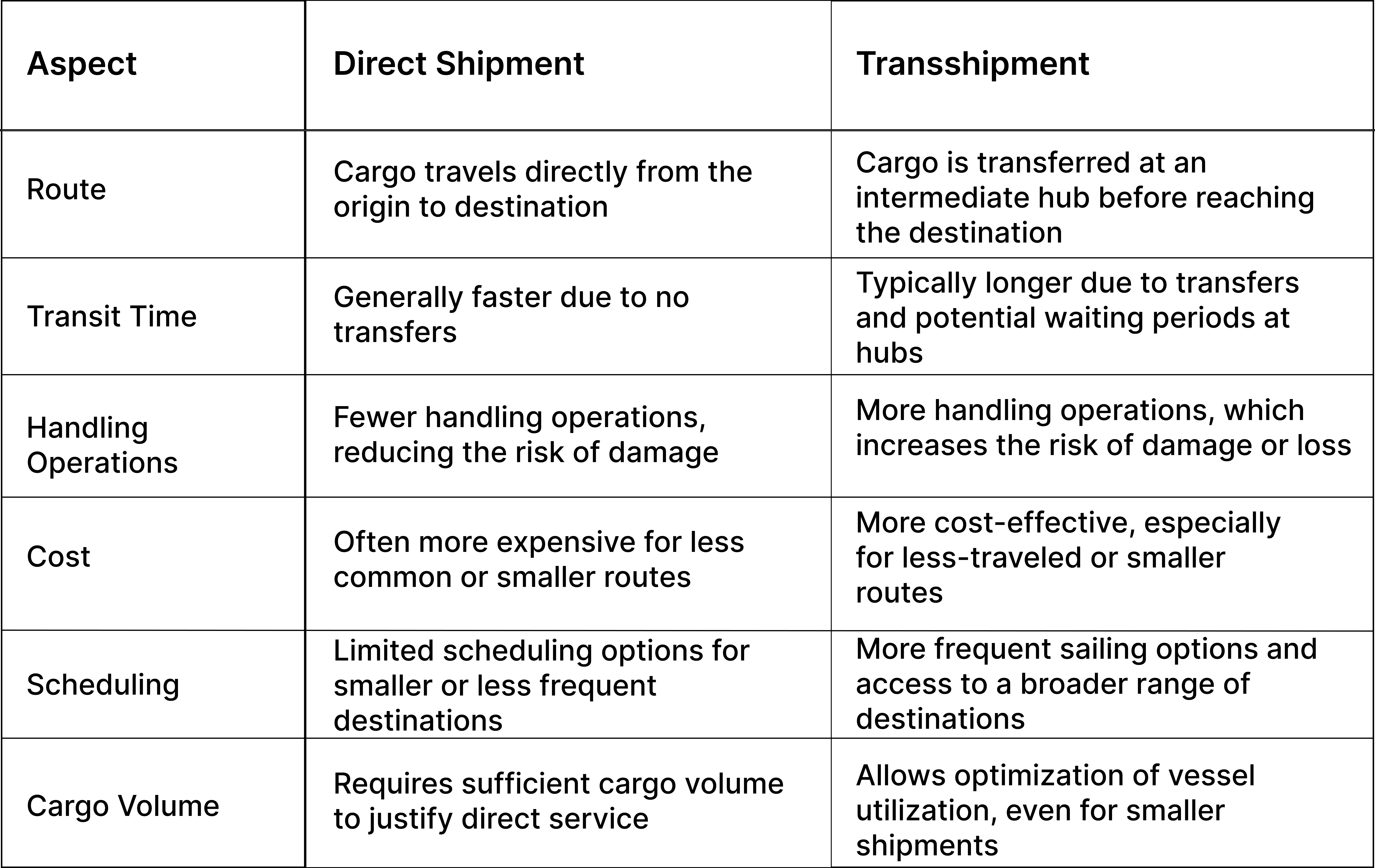Cargo does not always follow a direct route from origin to destination. Instead, it may pass through a transshipment hub, where it is transferred to another ship before continuing its journey. This strategic approach can significantly impact global shipping.
For exporters looking to expand their operations, transshipment allows access to distant ports and can help reduce shipping costs. Companies across various industries rely on this method to serve markets that might otherwise be difficult to enter. But how does the process unfold? Which hubs are most beneficial for exporters?
This guide explores transshipment meaning, offering insights into cost considerations and tracking methods to help businesses make informed shipping decisions.
What is Transshipment?
Transshipment is the process of moving goods to an intermediate location before they reach their final destination. During this process, cargo is transferred from one ship to another or, in some cases, from a ship to a truck or a train. The place where this transfer happens is called a transshipment port.
- Also Read: What is Cargo Insurance?
For example, if textiles are being shipped from Mumbai to New York, they might first go to Singapore. There, they are moved to another ship before continuing to the U.S. In this case, Singapore is the transshipment port.
What are the Reasons for Transshipments?
Businesses and logistics providers choose transshipment for several practical reasons:
Cost Efficiency
Direct routes to every possible destination would be economically impractical. Transshipment allows shipping companies to optimize their routes and maintain high vessel utilization rates.
Consolidation of Cargo
Transshipment hubs allow shipping lines to consolidate cargo from various origins, improving operational efficiency and reducing costs. For example, cargo from several countries can be brought to a hub like Singapore, then grouped and shipped together to one destination, saving money and reducing the number of trips.
Route Optimization
Using transshipment hubs strategically positioned around the world allows shipping companies to design more efficient networks with shorter travel distances, fewer empty runs, and better service patterns.
Limited Shipping Frequency
Direct services to smaller ports are less frequent. By using transshipment, exporters can access more regular shipments to larger ports, even if the final delivery to the smaller port happens less often.
What is the Transshipment Process?
The transshipment process typically follows these steps:
1. Initial Loading
Goods are loaded onto the first carrier (ship, truck, train, or aircraft) at the origin port or location.
2. First-Leg Transportation
The cargo travels to the transshipment hub.
3. Unloading at the Hub
Upon arrival at the transshipment hub, the cargo is unloaded from the first carrier.
4. Temporary Storage
The cargo may be temporarily stored at the hub's yard or warehouse while waiting for the connecting vessel or vehicle.
5. Customs Processing
Customs processing may be required depending on the country and regulations. However, many transshipment hubs offer special zones where cargo can be transferred without going through full customs procedures.
6. Loading onto Second Carrier
The cargo is loaded onto another vessel or vehicle for the final leg of transportation.
7. Final Transportation and Delivery
Once the cargo arrives at the destination port, it is unloaded and processed for final delivery to the consignee, reaching its intended location.
Types of Transshipment
Transshipment can be categorized based on various factors:
1. Based on the Mode of Transport
a) Sea-to-Sea Transshipment The most common type, where cargo is transferred from one vessel to another at a port. For example, if goods arrive on a large container ship at JNPT (Jawaharlal Nehru Port Trust) in Mumbai, they are then transferred to a smaller vessel for delivery to a smaller port like Cochin. This process allows cargo to reach destinations that larger ships cannot access directly.
b) Sea-Air Transshipment Cargo arrives by sea and continues by air. This method is used when time becomes a critical factor for part of the journey. Dubai is a major sea-air transshipment hub for Indian exports heading to Europe.
c) Air-Sea Transshipment This is the opposite of sea-air transshipment, where goods arrive by air and then continue their journey by sea. It's not as common but may be used for high-value items that need fast transport initially.
d) Intermodal Transshipment This involves multiple modes of transportation, such as sea-rail-road combinations. A shipment might arrive at a port by sea, be transferred to rail for inland transportation, and finally be loaded onto trucks for last-mile delivery.
2. Based on Legal Status
a) International Transshipment Cargo crosses at least one international border during the transshipment process. For example, goods from India going to the United States might transship through Singapore or Dubai.
b) Domestic Transshipment Cargo remains within the same country throughout the transshipment process. For example, goods from Mumbai being shipped to Port Blair might transship through Chennai.
3. Based on Purpose
a) Hub-and-Spoke Transshipment Large vessels serve main hub ports, and smaller vessels distribute cargo to regional ports. This is the most common model used in container shipping.
b) Relay Transshipment Cargo is transferred between vessels operating on different long-haul routes. This allows shipping lines to connect services that would not normally intersect.
c) Interlining Transshipment Cargo is transferred between vessels of different shipping lines, often as part of alliance agreements between carriers.
How to Track Transshipments?
Tracking transshipments is essential for businesses to maintain visibility over their cargo. Here are the common methods used:
Container Tracking Systems
Most shipping lines provide online tracking systems where you can enter your container or bill of lading number to check the status and location of your shipment.
Electronic Data Interchange (EDI)
EDI systems allow for the automatic exchange of shipping information between different parties in the supply chain, providing real-time updates on cargo movement.
Shipping Line Notifications
Many shipping companies offer email or SMS alerts for key milestones in the transshipment process, such as vessel departure, arrival at transshipment port, and loading onto the connecting vessel.
Third-Party Logistics (3PL) Platforms
These platforms aggregate data from multiple carriers and provide unified tracking interfaces for shippers who work with various transportation providers.
IoT Devices
Advanced tracking uses Internet of Things (IoT) devices attached to containers that transmit location data and even environmental conditions like temperature and humidity.
Using multiple tracking methods enhances reliability by offering comprehensive insights into cargo movement, ensuring better management and reducing the risk of delays or mishandling.
Difference Between Transshipment vs Direct Shipment
Understanding the major differences between transshipment and direct shipment can help businesses make informed logistics decisions:

Direct shipment is often used only when large volumes of cargo justify the cost, as it generally requires more resources and higher operational expenses. For smaller shipments or less frequent routes, transshipment offers a more cost-effective solution by utilizing intermediate hubs and optimizing vessel utilization.
Transshipment is an essential shipping method that facilitates the efficient movement of goods across global trade routes. It connects ports that don't have direct shipping routes. For Indian businesses trading with other countries, knowing what transshipment means and how it works can help them manage their supply chains better and save money. By working with skilled shipping companies and financial service providers like Drip Capital, Indian exporters can handle the challenges of transshipment and keep their cash flow steady during international trade.
Frequently Asked Questions
1. What is the role of transshipment?
Transshipment helps goods move across the world by linking ports without direct connections. It improves shipping routes, lowers transport costs, and supports trade between big and small ports.
2. What is the transshipment time?
It’s the time cargo stays at a port before moving to another ship, typically ranging from a few hours to a few days. Factors such as port congestion, weather conditions, ship availability, customs clearance, and cargo type can affect the duration, causing delays during busy times or adverse conditions.
3. Which are the busiest transshipment hubs in the world?
Some of the busiest transshipment hubs in the world are Singapore, Shanghai, Rotterdam, Jebel Ali, Hong Kong, and Colombo. Colombo is important for South Asian trade. In India, JNPT and Mundra are becoming major hubs.
4. How does transshipment work?
Goods arrive at a central port, are unloaded, stored briefly, and then loaded onto another ship. The process is managed using tracking systems, and shipping lines often work together to make it smooth.


